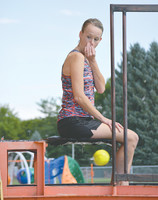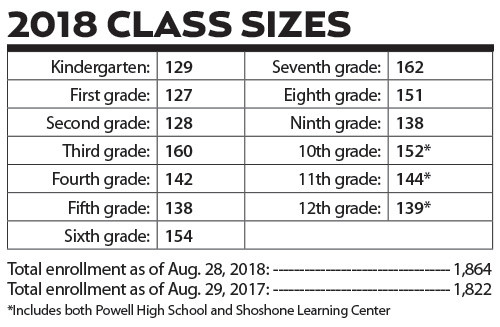Partly Cloudy, 68° F
Powell schools are packed.
“We have a whole bunch more kids this year than we did last year,” said Jay Curtis, superintendent of Park County School District No. 1.
The district …
This item is available in full to subscribers.
The Powell Tribune has expanded its online content. To continue reading, you will need to either log in to your subscriber account, or purchase a subscription.
If you are a current print subscriber, you can set up a free web account by clicking here.
If you already have a web account, but need to reset it, you can do so by clicking here.
If you would like to purchase a subscription click here.
Please log in to continue |
|


Powell schools are packed.
“We have a whole bunch more kids this year than we did last year,” said Jay Curtis, superintendent of Park County School District No. 1.
The district started the school year with 1,864 students — up 42 kids from a year ago at this time.
It marks the seventh consecutive year that enrollment has been up in this district, which includes Powell and Clark.
“It’s really good right now — we’re as big as we’ve been in a long time,” Curtis told the Powell school board last week. “There’s a lot of excitement in the buildings.”
In the elementary schools, third-graders make up the largest class, with 160 third-grade students across the district.
“Third grade is huge everywhere,” Curtis said.
The largest class overall is seventh grade, which has 162 students. Compared to other grades in the district, all of the middle school classes are big, with 154 sixth-graders and 151 eighth-graders.
“We have a big bubble right now in the middle school,” Curtis said, telling board members they’ll need to prepare for those larger classes as they advance to the high school.
Currently, the largest PHS class is 10th grade, with 151 students, while the junior class follows with 140 and the freshmen class has 138 kids. With just 125 students, this year’s PHS seniors make up the smallest class at the high school and in the district as a whole.
Curtis said he doesn’t think there’s any overcrowding yet, though the high school is feeling the influx of students with a total of 554 kids this year.
“And they’re going to get bigger in a couple of years,” said Greg Borcher, school board chairman.
“The day they opened that school it was too small,” added Trustee Kimberly Condie, referring to PHS.
The state School Facilities Commission determines the sizes of schools in Wyoming, and Curtis said the department learned its lesson since building PHS in 2008 and other schools across the state.
“Now they build to target capacity — what they’re seeing on the horizon — but that was not the case when they built our high school,” Curtis said.
Special accommodations may need to be made at PHS when the larger middle school classes arrive.
“At some point, when this attendance bubble comes through, there may come a time where we need to do a couple modulars to have a couple extra classrooms,” Curtis said.
Trustee Kim Dillivan asked if that could work at PHS.
Curtis said it’s “not a great long-term solution.” He added that when he taught in California, some classes were in modulars and the teachers liked them.
“Teachers out there had control over their own heat, they had control of their own air conditioning. They’re fine,” he said.
Trustee Trace Paul said one downside is that teachers would lose some of the collaboration with fellow coworkers by being outside of the main school building.
“It’s a little different when you’re out in a modular and two of your team members are inside of the building,” Paul said.
Chairman Borcher said PHS was built “to add on to it.” He said that could be an option if the state agrees to build another wing in the future.
Staffing at PHS will also need to be considered with more students at the school.
“I don’t want to hire any additional teachers … but there is a possibility of perhaps moving a few of teachers up from the middle school for a few years to accommodate the bubble as the smaller classes roll into the middle school,” Curtis said.
He said the district could creatively shift teachers around a little bit.
Borcher said new staff were added at the middle school to handle the increased enrollment, “so it makes sense if we move them up to the high school to handle it there, too.”
Curtis said the district will have to look at teachers’ certification, but most middle school teachers have their endorsement to teach grades six through 12.
“We would examine all of that,” he said.
The superintendent also told the school board that funding for future years will have to be considered. As the larger classes graduate in future years, the classes following them are not as big, meaning the Powell district will have fewer students overall.
“There’s about a five-year period there where we’re going to start losing kids,” Curtis said. “That’s going to be something we need to keep our eyes on. We’re going to have to be cognizant and aware of the implications of what that does for our funding, as we are an ADM model.”
ADM — average daily membership — is a main driver in how the state funds K-12 schools.
“For every student we lose, it’s a fairly significant financial impact,” Curtis said.
Borcher asked if there are any ideas to identify what’s bringing the additional students to Powell this year.
“We have no idea,” Curtis said.
The spike in numbers can’t be attributed to kindergartners. This year’s kindergarten class is 129 students, down from last year’s 136 kindergartners.
There are more students moving into the Powell district, but it’s unclear why.
“As far as I can tell, we don’t have any industry that’s hiring more people. There’s nothing that’s necessarily drawing people to our town,” he said. “Other than, I think, we can just take credit and say it’s the school system.”
Trustee Lillian Brazelton asked whether Powell got any additional students from Cody after Park County School District No. 6 leaders decided to allow trained staff members to carry firearms. While some Cody parents said they would take their students to Powell, “that never materialized,” Curtis said.
